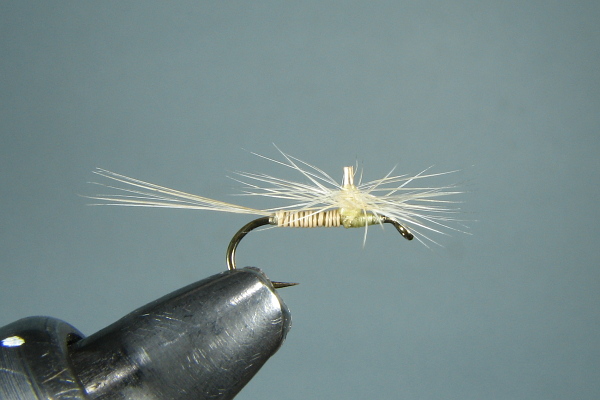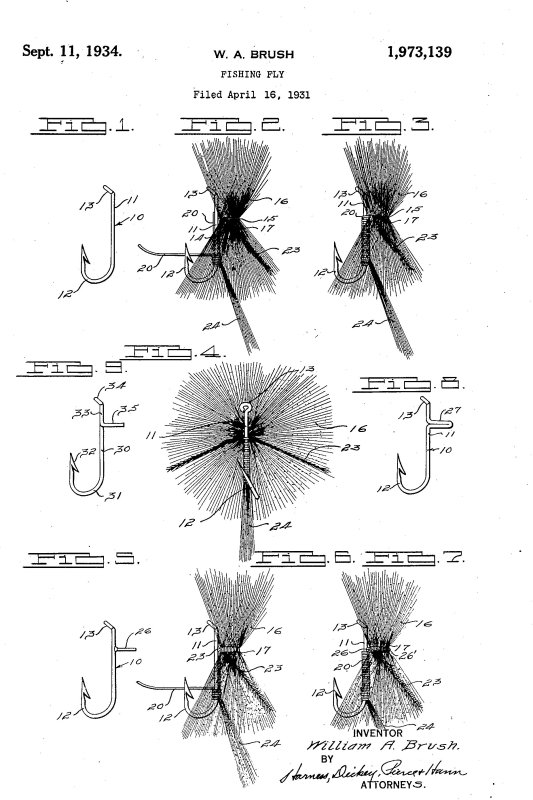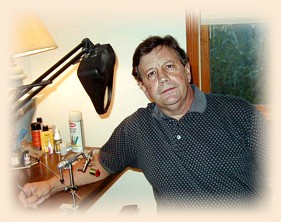

Welcome to 'just old flies,' a section of methods and flies that used-to-be. These flies were tied with the only materials available. Long before the advent of 'modern' tying materials, they were created and improved upon at a far slower pace than todays modern counterparts; limited by materials available and the tiers imagination.
Once long gone, there existed a 'fraternity' of anglers who felt an obligation to use only the 'standard' patterns of the day. We hope to bring a bit of nostalgia to these pages and to you. And sometimes what you find here will not always be about fishing. Perhaps you will enjoy them. Perhaps you will fish the flies. Perhaps?

The Gyrofly
I've often wondered about the origin of the parachute. Little by little, almost accidently, while researching other things, I've come to know more about its beginnings in America, and have been able to research the actual patent of the fly, initially dubbed the Gyrofly.
The story begins in Detroit, Michigan with a man named William Avery Brush. Mr. Brush developed this fly for fishing the Boardman River there, and in his patent he clearly describes his aims with the creation of the fly, and how he expected the fly would be ultimately tied. Here is the diagram from page one of the 1934 patent, #1,973,139:

Mr. Brush proposed a number of ways the horizontal hackle could be achieved, using the quill of the hackle itself as I've done, using special hooks as shown in figures 5, 8 and 9, and even mentions using wings to provide a "post" as we call it today. The point of the patent was to cover all possible bases that could be utilized in the future, and protect the basic idea.
Advantages claimed in the patent for this style of fly were several. If the shank of the hook was left bare, a very good spider was obtained. It was claimed that the fly would float longer, as the hackle wound horizontally would provide more area of contact with the water, thereby spreading the weight over a larger area, increasing surface tension. It was claimed that the fly, by nature of its "parachute" design, would float more slowly and gently down to the water. Once it touched down, the patent claimed that the fly would more closely resemble a live fly. It's interesting to note that one claim not made is the one that now is considered by many to be the biggest advantage of parachute flies, and that is that the body of the fly sits in the film as does that of a dun.
The fly was licensed exclusively to William Mills and Son initially, a large New York tackle dealer, for whom Ray Bergman tied. The term "Gyrofly" was coined by A.C. Mills, Senior. Ray Bergman gives us an example of the fly in Trout, a Ginger Quill which sports hackle tip wings and looks something like the Cahill I've done here:
In the meantime, the British were producing their own special hooks for parachutes, marketed by Hardy Brothers under the "Ride-Rite" name, Patent #379,343. These were quite unique in that there was a post built on to the hook, at the top of which was an eye which helped secure the parachute wraps.
Ultimately Mr. Brush began licensing the fly to other concerns, calling them "parachutes", and a star was born. I found in doing the fly at the top of the page that it was a great help to use the butts of the tail, quill, and hackle together to form the post. This gave me the neccessary stiffness required. Mr. Brush alludes to this in his patent as well. Neither he nor Bergman mention any thorax dubbing material as is commonly used today on most parachutes. That refinement came later, possibly from Alexander Martin. He used stout gut to form his post, not unlike the mono used today by the inventive English tier Roy Christie. Ray Bergman suggests using two hackles, utilizing both stems for the post, and winding the hackle around both of them. This is great for larger flies, but the post will be too wimpy for small ones, like the #18s I show here. It really helps to add the tail butts and quill butts to the post in this case. I've done more of a Cahill with my Gyros, as they're hatching here right now. Here's the recipe Bergman shows for his "Ginger Quill Gyro":
Dressing
Ginger Quill Gyro (Bergman)
Credits:
The Fly Fisher's Illustrated Dictionary By Darrel Martin;
Trout by Ray Bergman ~ EA
About Eric:

Eric lives in Delaware, Ohio and fishes for brown trout in the Mad River, a beautiful spring creek.
More of his flies are on display here: traditionalflies.com -- Classic salmon and trout flies of Europe and the Americas
[ HOME ]
[ Search ] [ Contact FAOL ] [ Media Kit ]